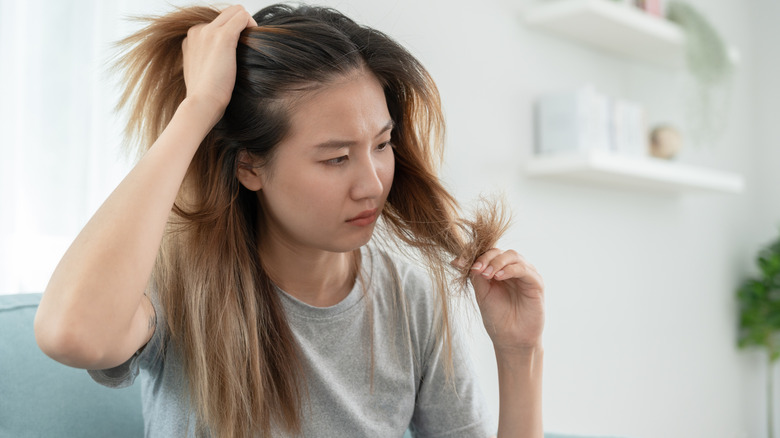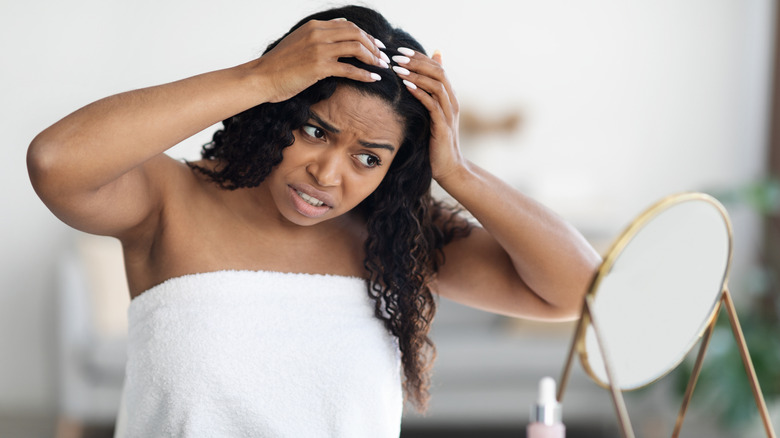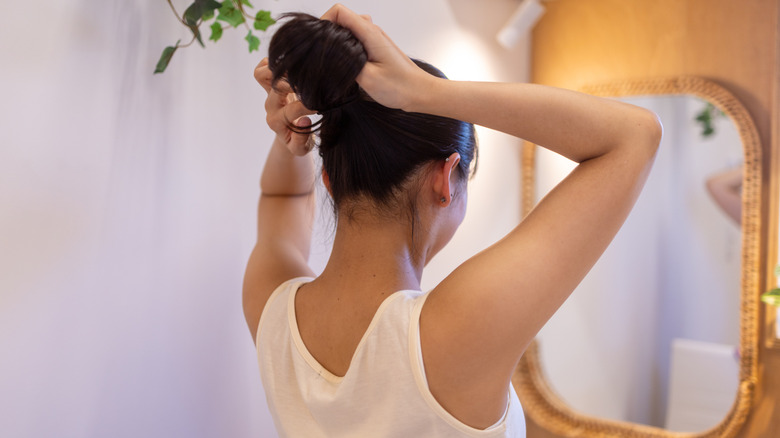The Four Most Common Causes Of Hair Loss, Explained
Although our culture often equates hair loss with something mostly experienced by men, the reality is that hair loss occurs regardless of gender. According to research by Harvard Medical School, almost one-third of women will lose their hair at some point during their lifetime, and that percentage jumps to two-thirds after menopause. In other words, no matter the reason, hair loss is common and affects millions of people.
While many people deal with hair loss, it can feel world-ending when it happens to you. But here's the thing: there's no one reason why someone might see their locks thin, and it's certainly not because of anything you did. From hormones to stress to an autoimmune condition, why you're seeing increased hair loss can really run the gamut. "Your hair is an organ — the second-smallest organ in the body —and it is complex and sophisticated. Scientists are still learning about the complex symptoms of the hair follicle and why it stops and starts," certified trichologist, Penny James, exclusively tells Women, adding that maintaining a healthy lifestyle, reducing stress, and avoiding toxic environments are the first steps toward hair loss prevention.
If you notice your hair isn't as thick as it used to be, it could simply be the hair changes that come with age and the fact that you need to change with it. If positive changes in how you care for and maintain your hair don't help, then it might be something else. There are four common causes behind hair loss, and James exclusively gives Women the lowdown on all of them.
Alopecia areata
Although alopecia areata ultimately affects the hair, it's an autoimmune skin disease. According to the National Alopecia Areata Foundation, as many as 160 million people worldwide will develop alopecia areata at some point. "It is a non-scarring disease, meaning the hair will fall out and then regrow," says Penny James. "Evidence has shown there is a correlation between genetic diseases and other autoimmune diseases like rheumatoid arthritis and type 1 diabetes."
While alopecia reata can affect anyone of any age or gender, a 2023 study published in JAMA Dermatology found that women and people of color are disproportionately affected, and a 2015 study published in Clinical, Cosmetic and Investigational Dermatology found that the majority of people, at 80%, show signs of alopecia areata before the age of 40. As James explains, alopecia areata targets the healthy hair follicles while they're in their anagen (growing) stages. Although researchers know that this is the reason for thinning hair or bald patches, they have yet to figure out why there's a gene that does this in the first place.
But what scientists do know is that it's not something you can remedy by laying off your favorite hair tools, like hot rollers, or limiting how often you use the hair dryer. Instead, it requires prescribed medication. "There are new, very effective drugs on the market called JAK inhibitors that suppress alopecia areata," says James, adding that once you start this medication, you're on it for life. However, if taking a daily oral or topical medication doesn't fit your lifestyle, James suggests talking to a trichologist or dermatologist about other options.
Telogen effluvium
While you may be able to blame a relative for alopecia areata, that's not the case with telogen effluvium. As Penny James exclusively tells Women, this type of hair loss is one that's acquired. "It is a non-scarring type of hair loss and is often triggered by illness, poor diet, stress, to name a few," says James. In fact, stress is so tied to telogen effluvium that according to the American Academy of Dermatology Association, there's been an uptick in hair loss linked to those who have had COVID-19. As many as 20% of people experience hair loss within a few months of having had the disease.
Although telogen effluvium can affect anyone at any age, women are more susceptible due to hormonal fluctuations and metabolic stress, according to a 2024 study published in Stat Pearls. "Telogen effluvium is when the hair is shedding throughout the scalp, resulting in diffuse thinning," says James. "New hair will regrow, but will fall out prematurely."
In addition to hormones and stress, medications, like GLP-1, and nutrient deficiencies can also play a role in this type of hair loss. "When it comes to your health, what you eat is who you are," says James, adding that having a well-balanced diet that's chock-full of necessary nutrients, minerals, protein, and vitamins can help reduce hair loss. If your lifestyle and diet are on the up and up, but you're still losing your hair, James advises getting your hormone levels checked, something you should do once a year anyway, to see if that could be the source of the issue.
Traction alopecia
When it comes to traction alopecia and the risk it poses to your hair health, know that, among other things, it's a form of scarring alopecia, it's acquired, and it can be reversed. It's also something that you can easily avoid by switching up how you style and wear your hair. "[Traction alopecia is the result of] tight ponytails, ballerina buns, sister locks, hair weaves, wigs, tape-in hair pieces, and bonded hair extensions," Penny James exclusively tells Women. "When any of these are used or your hair is styled for a long period of time, years of the same style, added hair loss will occur."
You may not realize it, but every time you wear your hair in a specific look that requires a tight pull, the hair is being pulled out or broken during the anagen stage, which is necessary for it to fully grow. As James explains, this leads to vellus hairs, also known as peach fuzz. "It is a miniaturized hair shaft, now in place of the terminal hair," explains James. To get around causing this type of damage, it's all about letting your hair rest. "For example, a ballerina bun — one week, pull all hair back into the top of the bun. Next week, create a center parting, then pull back into a bun," says James. When it comes to things like weaves, wigs, and extensions, go au naturel for a month, so your hair has the opportunity to get back on a healthy track that allows its growth not to be interrupted.
Female pattern hair loss (FPHL)
Also known as androgenetic alopecia, female pattern hair loss (FPHL) is the type of balding that's caused by hormonal changes, genetics, aging, or all of the above. According to a 2015 study published in the Journal of the American Academy of Dermatology, as many as 40% of women are affected by FPHL by the time they reach 50. While there's no cure for FPHL, it can be treated through medication like that prescribed for alopecia areata; however, it's important to realize these two types of hair loss are completely different. The latter is due to an autoimmune disease, while the former is common baldness that can happen to anyone as they get older. That being said, there are ways to maintain healthy hair into your 50s and beyond that don't necessarily require prescription medication.
Although each type of hair loss is distinctly different in how it presents itself — for example, alopecia areata shows up as bald patches and telogen effluvium resembles shedding instead — it's always important to see a professional. "Book an appointment with a trichologist or a dermatologist who specializes in hair and scalp problems," says Penny James. There's absolutely no shame in hair loss, no matter the cause of it, but you do want to know what's going on in your body in case it's indicative of something more serious. In fact, a life with little-to-no hair can be quite liberating, and sometimes reaching for a razor and going for a bold buzzcut is the beauty reset you need in your life.




